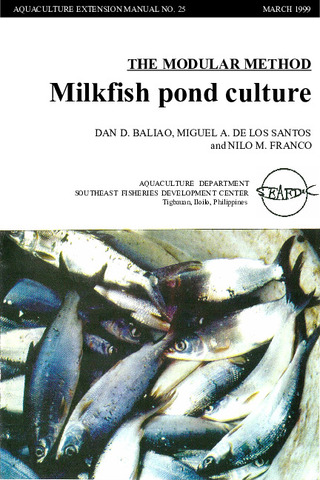Production of hatchery-bred early juvenile milkfish (Chanos chanos) in nursery ponds through supplemental feeding
- Global styles
- MLA
- Vancouver
- Elsevier - Harvard
- APA
- Help

Download URL
www.abah.bioflux.com.roDate
2012Author
Page views
3,233ASFA keyword
AGROVOC keyword
Taxonomic term
Metadata
Show full item record
Share
Abstract
Hatchery-bred early juvenile Milkfish (Chanos chanos Forsskål, 1755) (average weight of 0.45 g) were stocked in a 500 m2 nursery pond at a density of 16 juveniles/m2 during the dry months (March-May). The early juveniles were reared for two months with natural food followed by supplemental feeding. Upon the harvest the fish reached an average weight of 9.30 g and a survival rate of 86.9%. A feed conversion ratio (FCR) of 1.08 was attained, with specific growth rate (SGR) of 4.96%/day. The high survival rate and good production could be attributed to the time of the year when the nursery production trial was conducted. The nursery of milkfish in ponds during the summer months ensures sufficient supply of natural food and stable water quality during the crucial phase in the nursery production. This strategy of rearing early juveniles (<1 g) of milkfish in nursery ponds at high stocking densities using a combination of natural food and supplemental feeding could be one of the alternative approaches in the nursery production of this fish.
Suggested Citation
Jaspe, C. J., Golez, M. S. M., Coloso, R. M., & Caipang, C. M. A. (2012). Production of hatchery-bred early juvenile milkfish (Chanos chanos) in nursery ponds through supplemental feeding. Animal Biology and Animal Husbandry , 4(2), 32-37. http://hdl.handle.net/10862/2226
Type
ArticleISSN
2066-7612; 2067-6344Collections
- Journal Articles [1256]
Related items
Showing items related by title, author, creator and subject.
-
Series: Aquaculture extension manual; No. 25
The modular method: Milkfish pond culture
Baliao, Dan D.; de los Santos, Miguel A.; Franco, Nilo M. (Aquaculture Department, Southeast Asian Fisheries Development Center, 1999)The modular method of milkfish culture (Chanos chanos) described in the manual is an improvement over the traditional extensive method. The manual is intended for the use of fish farmers and aquaculturists, extensionists, ... -
Evaluation of organic and inorganic fertilizers in brackishwater milkfish ponds
Bombeo-Tuburan, Isidra; Agbayani, Renato F.; Subosa, Precilla F. (Elsevier, 1989)The study was conducted in twelve 144-m2 ponds to evaluate the effect of different organic and inorganic fertilizers on the growth, survival, gross production, and profitability of marketable milkfish. The ... -
Milkfish breeding and hatchery technology at SEAFDEC/AQD
Unknown author (Aquaculture Department, Southeast Asian Fisheries Development Center, 1999)Describes the techniques already adopted by the private sector: broodstock management, broodstock diet, commercial fry production, live transport, and larval diet. A list of AQD research publications on milkfish is included.





